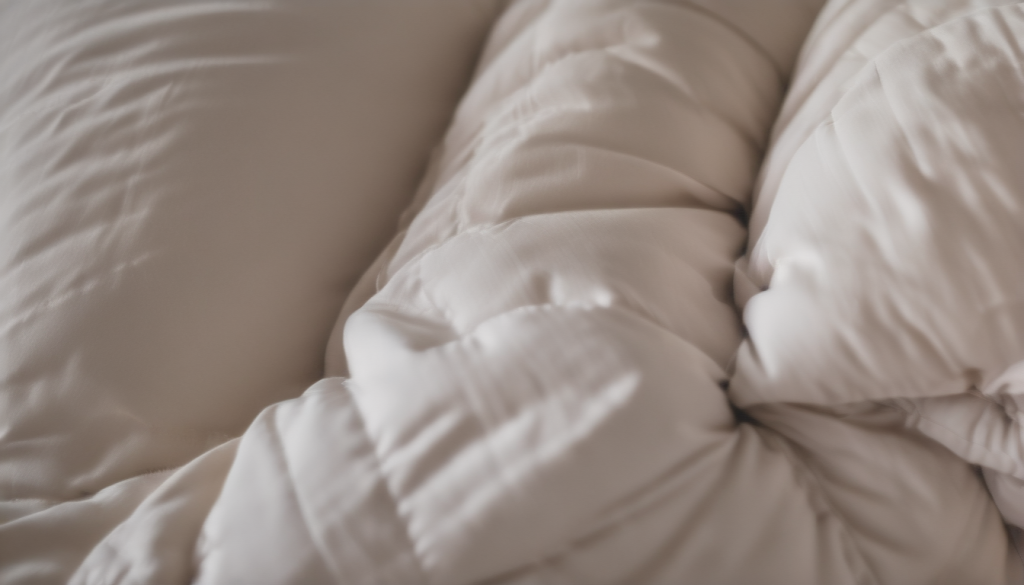Welcome to the wonderful world of down comforters! If you’re new to these über-cozy bed covers filled with fluffy down feathers, you’re in for a treat. This comprehensive guide will teach you everything you need to know – from fill power to thread count, shopping tips to cleaning tricks. Snuggle up under the warm embrace of knowledge as we delve into the science, selection, and care of down comforters!
What Are Down Comforters?
A down comforter is type of duvet or quilt filled with the fine, fluffy plumage found underneath the exterior feathers of ducks and geese. This super-soft down filling is known for its unmatched insulation properties that trap body heat, providing a cozy night’s rest all year round.
Unlike regular blankets or bedspreads, the fill inside a down comforter is what provides its legendary comfort and warmth. The outer shell or cover is typically made from a lightweight, breathable fabric like cotton sateen to avoid trapping sweat.
Compared to synthetic down alternatives also used in comforters, real down offers superior:
- Warmth – Down clusters trap more air to better retain body heat
- Lightweight feel – Less filling material required for warmth
- Durability over time with proper care
- Luxurious comfort loved by bedding aficionados
Ready to upgrade your sleeping experience? Read on!
How Do Down Comforters Keep You So Warm?
Here comes the science! The exceptional warmth of down comforters stems from the special structure and properties of down clusters.
Down refers to the layer of fine underfeathers that grow close to a duck or goose’s body to provide insulation from cold weather and water. These feathers have tiny hollow shafts that trap body heat created by the bird.
In a down comforter, these soft feather clusters continue trapping radiant body heat from you to return it back under the covers. This creates a cozy, breathable layer of insulation.
The fill power indicates how “fluffy” the down is – it measures the space one ounce of down takes up in cubic inches when fully lofted. The higher the number, the better it insulates.
| Fill Power | Quality |
|---|---|
| 400-550 | Low |
| 550-650 | Good |
| 650-900 | Excellent |
This loft space essentially provides ventilation that allows moisture and excess heat to escape so you don’t overheat. Down offers the highest warmth-to-weight ratio amongst bedding materials.
No wonder down comforters have a reputation for dreamy comfort!
Decoding Down Comforters: Key Factors to Consider
When choosing a down comforter, you’ll want one with quality construction from premium materials that enhance comfort and durability while meeting your needs. Keep these characteristics in mind while shopping.
Fill Material: Goose vs Duck Down
Goose and duck down provide different qualities depending on the type of bird.
| Goose Down | Duck Down | |
|---|---|---|
| Pros | warmer, more durable, more supply | cheaper, still insulating |
| Cons | pricier | lower durability, less supply |
| Best Use | luxury bedding | budget choice |
Goose down comes out ahead for its exceptional insulation abilities yielding maximum warmth from less filling. It also lasts longer with proper maintenance.
Duck down gets points for affordability, though the shorter fiber length means less loft space to hold warmth. Supply chain issues also make duck down more scarce.
Fill Power: The Enhancer of Warmth
We touched briefly on fill power as the measurement of volume down occupies. Basically – higher fill power number = more trapped air = more warmth.
Most quality down comforters now boast fill powers of 600-850. For ultra-indulgence, 900+ fill power hits hotel collection level.
Lower fill powers around 500 remain popular for budget buyers willing to compromise a little on warmth. Some also prefer less loft for a more streamlined silhouette.
When evaluating warmth, also note the fill weight – that’s the total mass of down inside measured in ounces. More ounces = more insulation!
Fabric Cover: Theories on Thread Count
Fabric covers protect delicate down while contributing cozy factors through handfeel. Cotton sateen is a top choice – it’s smooth, breathable, and woven tighter than basic cotton for durability.
Thread count refers to the number of threads woven together per square inch. In sateen shell fabric, look for:
- 300+ for softness, longevity
- 400-500 for borderline indulgent levels
- 600+ for luxury hotel quality
While higher thread counts promote smoothness and strength, going too high reduces breathability. Around 400 hits the sweet spot for most sleepers.
Shopping for the Perfect Size

One rookie mistake is choosing the wrong size down comforter for your bed. Make sure to double check mattress dimensions against comforter sizes.
Some standard comforter dimensions:
- Twin: 68″ x 86″
- Queen: 90″ x 94″
- King: 112″ x 94″
Size up for extra wiggle room or oversized beds. Longer styles allow pocketing under the mattress.
Caring For Your Precious Down
To maximize longevity, be gentle and limit washing to a few times per year. Here are some top care tips:
Cleaning: Only dry clean if the tag says so. Most can be home washed on delicate/gentle cycles in large capacity machines. Use mild detergent.
Drying: Tumble dry on a no-heat or air fluff setting. Adding clean tennis balls helps re-fluff!
Storing: Let the comforter fully dry out before seasonal storage to prevent mildew growth. Store in breathable cotton cases.
Fluffing: Frequently shake out and re-loft the comforter to minimize cold spots.
With the right handling, a quality down comforter can last over 10 years!
Level Up to All-Season Warmth
For reliable coziness in every season, look for these all-season comforter features:
- Baffle box design prevents fill shifting
- Light, breathable cover like 300-thread count cotton
- Channel-stitched chambers keep filling evenly dispersed
- Corner loops to attach duvet cover
- Natural fill materials mapped into zones
The key is finding the right balance of insulation for year-round use. Here are two popular options:
- Three-in-one style: Interchangeable lightweight, midweight and heavyweight inserts to mix & match
- Reversible style: Attached two-tone cover with warmer and cooler sides
Some all-season comforters even let you unzip sections to adjust fill!
Add a coverlet in summer, or layer blankets underneath come winter. Now you can save money on buying multiple comforters while keeping perfectly comfortable every night!
Hypoallergenic Options for Sensitive Sleepers
For those susceptible to allergies from natural down or feathers, specialized hypoallergenic down comforters can provide relief.
Advancements in down processing use intensive cleaning methods to remove the light particle allergens that trigger reactions. Multi-rinse purification baths strip the down and microfilters catch dander.
Look for hypoallergenic certification from IDFL and DOWNPASS when shopping:
Even after thorough sanitization however, down doesn’t suit those severely allergic. In that case, the ultimate allergy-free choice would be a synthetic-filled comforter. Primaloft and microfiber mimic properties of down well at a more affordable price point.
Understanding Luxury Down Comforters
At the highest tier lie exceptional European white down comforters promising utmost quality:
Filling: 90-95% large, mature goose down hand-sorted for purity. This ultra-fine grade delivers unrivaled loft and cloud-like texture.
Construction: Box baffle style with double or triple stitching prevents shifting while maximizing loft space. Stronger seams reinforce fill capacity for amplified warmth. Corner ties keep duvet covers anchored.
Cover Fabric: 500-600-thread count, long-staple cotton woven in Italy or Belgium. Stone-washed for exceptional softness.
Craftsmanship: Skilled baffle-box design, hand cutting and precision stitchwork ensure longevity.
Ethics: Premium ethically-sourced goose down adheres to animal welfare standards. Certified through IDFB.
Price: $1000+ for Queen sizes due to meticulous sourcing, manufacturing and attention to quality. Worth every penny for lifetime warmth.
While out of reach budget-wise for many, one splurge-worthy luxury down comforter can literally last decades with proper care. Making the investment pays dividends in restful sleep for years to come.
Eco-Friendly Considerations
For the sustainability-minded shopper, searching for environmentally friendly down comforters offers peace of mind.
Organic down certification ensures the birds were:
- Given a high-quality diet sans artificial hormones or antibiotics
- Allowed outdoors access and space to roam
- Harvested ethically for feathers through non-live plucking
This attention to humane standards makes Certified Humane®, Downpass, and Responsible Down Standard labels reliable green choices.
Meanwhile, OEKO-TEX® certifies comforters free from harsh chemical treatments. Bluesign® approval evaluates sustainable manufacturing practices.
Going green feels good!
The Latest & Greatest in Down Comforters
Exciting new technologies keep improving down comforters every season:
- Zoned insulation with smart mapping of down proportions to heat or cool different areas like the core, shoulders and feet.
- Adjustability through zip-off sections, corner ties, and elastic strapping so sleepers modify fill levels.
- Temperature regulation integrating Outlast® phase change materials, cooling gels, moisture wicking, and other tech to prevent overheating.
- Hypoallergenic solutions that are truly non-allergenic for every sensitivity level.
- Sustainability through recycled water systems reducing environmental impact.
The future holds even cozier, customizable comforters!
Accessorize Your Down Comforter
While a duvet cover isn’t essential, it allows changing up your bedding aesthetic seasonally plus protects against soiling. For best results:
- Choose breathable cotton, linen or poly-cotton blend materials
- Look for durable hidden zipper closures
- Carefully measure mattress height for proper fit
- Anchor corners under the mattress
Flannel duvet covers add wintery warmth while lightweight percale keeps summer nights cool.
Coordinating shams, throw pillows and blanket layers take your bed’s cozy factor up another notch!
In Summary…
Who knew such luxurious comfort could come from the under-plumage of ducks and geese? When wrapped under the warmth of fine fill power down enclosed by soft, breathable fabric, you’ll drift off feeling like royalty.
We covered everything from choosing optimal materials, handy care tricks and the latest innovations advancing comfort technology. Just don’t get too blissfully comfortable – you still have to get out of your cozy nest eventually!
Here’s to many rewarding nights of rejuvenating rest ahead. Sleep well, friend.
Frequently Asked Questions
What is the benefit of using a down comforter?
Down comforters provide exceptional warmth and coziness thanks to the unique insulation properties of waterfowl down fill. The fluffy feather clusters trap air to retain body heat, creating a comfortable layer of warmth ideal for a restful sleep experience. Down also offers an unmatched lightweight feel compared to other insulating fills.
How do I know if a down comforter will keep me warm enough?
Focus on the fill power, typically shown with the product details. The higher the number, the better the trapped loft and insulation capacity. Goose down fill above 600 fill power excels in warmth, while duck down may rate a bit lower. But any quality down comforter with ample fill weight (ounces) and proper construction like baffle boxing will ensure adequate warmth for most seasons.
What thread count is best for down comforter covers?
For optimal softness, breathability and durability, look for a cotton sateen shell with 300-500 thread count. 600+ thread counts can inhibit airflow. The tighter weave around 400-500 threads/square inch provides the ideal balance of coziness and temperature regulation. Luxury down comforters may use 4-500 thread count imported European cotton sateen.
How often should I wash my down comforter?
Only wash 1-2 times per year as needed – too frequent cleaning damages down feathers. Use a mild delicate detergent on the gentle cycle, then dry with tennis balls to restore loft. Proper storage keeps comforters cleaner longer: place in large breathable cotton cases. With light use, an investment down comforter can last over a decade thanks to quality materials like high fill power European goose down.
Why choose a down comforter over alternative bedding?
For unmatched warmth, breathability and cushy comfort, down comforters beat out all other bed covers like heavier quilts or cheaper polyfill types. Only natural goose or duck down offers the unrivaled insulation properties to generate cozy warmth without heaviness or sweating. Responsibly-sourced premium down makes for the ultimate luxurious sleep experience outlasting other bedding options.








